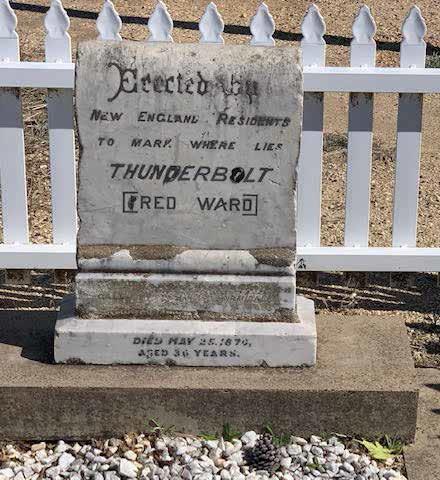Last weekend seemed a good time to take a break in the bush and leave behind the outbreaks of COVID-19 in Sydney hotspots.
Intensive internet searching found an isolated farm cottage just within a day’s driving distance.
The name of the hamlet nearest to the farm sounded familiar to me, like something from a song.
As a much younger person I had been steeped in Australian lore by my mother and have a wide acquaintance with Australian stories, poems and songs.
Not so my travelling companions, younger daughter known as Cuddles the Thug and my lovely nephew, despite both having worked in Australia for quite some years.
I had obviously failed to pass on my inherited knowledge of Australiana.
I immediately started humming and warbling the few words I thought I remembered, something about ‘running, running, running on the something piece of land, free selected on them somewhere or other shore’.
This was not greeted with the enthusiasm it should have been, despite explaining to them about the dramatic lives of noble pioneers in the outback.
They started talking about the shaming treatment of the Aboriginal people whose land it rightfully was.
Sadly too true, but I got on the internet to at least look up the proper words of the song.
As is the way with much of Australian popular history of daring-do, it turned out to be a ballad about cattle duffing (rustling) and horse stealing.
Even Australia’s national song ‘Waltzing Matilda’ (as opposed to the national anthem) is about a tramp who camps by a waterhole and catches sheep belonging to a squatter (farmer).
He hides them in his tucker bag (food bag) when the troopers (police) come and drowns in the creek to avoid being caught.
Anyway, the song I was trying to sing turned out to be about another place with a name similar to where we were headed, but not the one of cattle duffing fame.
Never mind, according to a road-tripping enthusiast friend, we would be able to get where we were going by taking the scenic, winding Thunderbolt Way.
“No way,” said the driver, we needed to get where we were going before dark.
So while I endeavoured to give the younger generation a crash course on Australian words and song, we zapped along the amazing, well signposted highways that allow vehicles to hurtle from one place to another at 110kph.
Of course, they don’t get the sort of rain we of the tropics know, that destroys our roads.
The further we went, the higher we got and the colder it was.
We were alternately bathed in sunshine (but still cold) and pelted with rain and sleet.
We had been warned of black ice, but either it wasn’t there or we didn’t recognise it.
We were driving carefully, paying attention to our Google electronic map, as it was now getting late.
We made contact with the farmer who owned the cottage, who gave us directions on how to get there because the internet/mobile phone contact was intermittent, as in usually unavailable.
This really was the outback.
Anyway, we would know the place because it was down a gravel road and had a tin black cow letterbox. Oh right, a black cow on a now black night.
However we found it and next morning were treated to a scene of rural splendour, trees overhanging a river bend reputedly inhabited by duck-billed platypus and real black cattle dotting a landscape of rolling hills with noble gum trees.
We spent the next two days touring the area, visiting the large country town of Armidale familiar to some of Fiji’s early academics, who went to the University of New England there.
To my huge delight, we found Thunderbolt Way by accident while our electronic map on the mobile phone continued to be ‘intermittent’, as in not happening.
The driver could hardly refuse to go along it in broad daylight.
The road is named for, unsurprisingly, an Australian bushranger (highwayman) who held up travellers (stand and deliver) and stole from them. His real name was Fred Ward, but was self-styled as Captain Thunderbolt.
It seems he had a difficult youth, falling in with some bad lads and ran gangs that included some of his cousins. He had a full life on the run, including acquiring a wife and several children. He also did a stint on Cockatoo Island, a prison in Sydney Harbour, from which he escaped.
He was eventually caught and shot dead by police near Thunderbolt Rock, a bunch of huge boulders where he used to hide while waiting for unsuspecting travellers.
As is the Australian way, he became a legend, seen as a daredevil underdog who bested the police on many occasions.
Residents of the nearby town, Uralla, have erected Captain Thunderbolt a memorial gravestone in their pioneer cemetery, noting his death in 1870 aged 36.
Thunderbolt Rock, surrounded by Australia’s emblem wattle trees, is now daubed with graffiti.
Maybe he would have approved of this demonstration of defiance of the law and respectful behaviour.
We were happy to leave Thunderbolt to have his way in the high country because that night there was a low temperature of minus two degrees.
Enthusiastic use of heaters and hot water blew a fuse at the cottage that left us in the cold and dark, with frost on the ground and ice on the windscreen next morning.
The white and frosted landscape was gilded with blooming wattle, Australia’s floral emblem.
As my mother used to recite: The flowering golden wattle, is the emblem of our land. You can stick it in a bottle, or hold it in your hand.
* The views expressed in this article are the author’s and not necessarily shared by this newspaper.



